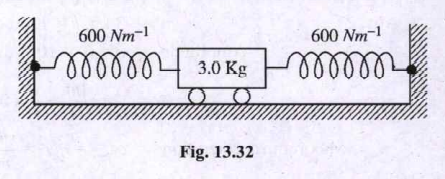ADDITIONAL SOLVED PROBLEMS from S CHAND PHYSICS (ENGLISH) OSCILLATIONS for Class 11
| Class 11 | PHYSICS |
| Chapter | OSCILLATIONS |
| S CHAND PHYSICS (ENGLISH) | ADDITIONAL SOLVED PROBLEMS |
| Medium | English |
| Academic Year | 2023-2024 |
Question 10
A mass of 400 g is connected to a massless spring of force constant 10.0 N/m and is made to oscillate on a frictionless horizontal table. The mass is displaced 10 cm from the equilibrium position and released from rest. (i) What is the period of oscillations ? (ii) Find the maximum speed of the mass (iii) What is the maximum acceleration of the mass ? and (iv) what is the total energy of the mass ? [See Fig ]
 View Solution
View SolutionQuestion 24
Figure (a) shows a spring of force constant k clamped rigidly at one end and a mass attached to its free end. The spring is stretched by a force F at its free end. Figure (b) shows the same spring with both ends free and attached to a mass m at either end. Each end of the spring in Fig.(b) is stretched by the same force F.
(i) What is the maximum extension of spring in the two cases?
If the mass in (a) and the two masses in (b) are released free, what is the period of oscillation in each case ?
 View Solution
View SolutionQuestion 25
A spring of force constant 1200Nm−1 is mounted on a horizontal table as shown in Fig. A mass of 3.0 kg is attached to the free end of spring, pulled sideways to a distance of 2.0 cm and released.
(a) What is the frequency of oscillation of mass ?
(b) What is its maximum acceleration ?
(c) What is its maximum speed ?
 View Solution
View SolutionQuestion 26
A tray of mass 12 kg is supported by a two identical springs as shown in Fig. When the tray is pressed down slightly and released it executes shm with a period of 1.5 s. What is the force constant of each spring ? When a block of mass m is placed on the tray, the period of shm changes to 3.0 s What is the mass of the block ?
 View Solution
View SolutionQuestion 27
A trolley of mass 3.0 kg is connected to two identical springs each of force constant 600 Nm as shown in Fig. If the trolley is displaced from its equilibrium position by 5.0 cm and released, what is (a) period of oscillation, (b) the maximum speed of the trolley, (c) how much is the total energy dissipated as heat by the time the trolley comes to rest due to damping force ?
 View Solution
View SolutionQuestion 28
A trolley of mass 3.0kg is connected to two identical springs each of force constant 600Nm−1as shown in figure 13.32 (amplitude=5cm)
Problem (a) period of oscillation
Problem (b) the max speed of trolley.
If the spring in the problem are replaced by rubber bands, what is the answer to the question (a) and (b) in the problem if K of rubber band is 600Nm−1 during extensions. View SolutionQuestion 30
A 3 kg collar attached to a spring of force constant 1200Nm−1 slides without friction on a horizontal rod. The collar is displaced from its equilibrium position by 6.0 cm and released. Calculate (a) the period of oscillation, (b) the maximum magnitude of acceleration and (c) the maximum speed of collar. (Fig)
 View Solution
View Solution
All Exercises from S CHAND PHYSICS (ENGLISH) Class 11 PHYSICS OSCILLATIONS
- SHORT ANSWER QUESTIONS WITH ANSWER
- LONG ANSWER QUESTIONS
- SHORT ANSWER QUESTIONS
- VERY SHORT ANSWER QUESTIONS
- SELECTED PROBLEMS (FROM ENERGY OF AS.H. OSCILLATOR )
- SELECTED PROBLEMS (FROM THE CHARACTERISTIC OF SHM)
- SELECTED PROBLEMS (FROM TIME PERIOD OF OSCILLATION OF A S.H. OSCILLATOR)
- SELECTED PROBLEMS (OSCILLATION IN A TUNNEL BORED THROUGH THE EARTH)
- SELECTED PROBLEMS (PERIOD OF OSCILLATION OF (I) A LIQUID IN A U-TUBE, (II) TEST TUBE FLOAT, (III) (III) A PISTON IN AN ENGINE ETC.)
- ADDITIONAL SOLVED PROBLEMS
- SOLVED EXAMPLE

